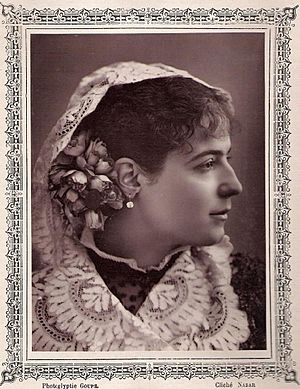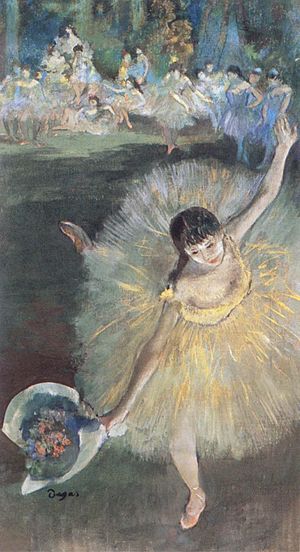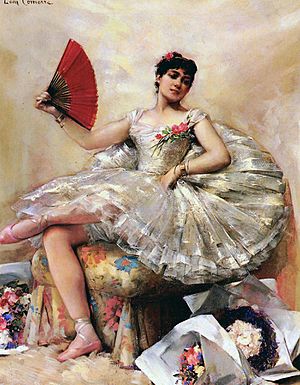Rosita Mauri facts for kids
Quick facts for kids
Rosita Mauri
|
|
|---|---|

Portrait head by Nadar, 1881
|
|
| Born |
María Isabel Amada Antonia Rosa Mauri Segura
15 November 1850 |
| Died | 3 December 1923 (aged 73) |
| Burial place | Montparnasse Cemetery |
| Nationality | Spanish |
| Occupation | Dancer and ballet teacher |

María Isabel Amada Antonia Rosa Mauri Segura (born September 15, 1850 – died December 3, 1923) was a famous Spanish dancer and ballet teacher. She was also known as Roseta Mauri y Segura.
Rosita Mauri became a top ballet dancer, known around the world. Many artists, sculptors, and photographers created works inspired by her. Poets also wrote tributes about her.
Contents
Becoming a Star Dancer
Rosita Mauri's father, Pedro Rafael Jaime Mauri, was a ballet teacher and choreographer. He trained her from a young age to become a star. Rosita grew up in Reus, a city sometimes thought to be her birthplace.
She started her dancing career in 1865. Her journey to becoming one of Europe's best ballerinas began in 1877. This was when the French composer Charles Gounod saw her dance in Milan, Italy.
Gounod was so impressed that he convinced the famous Paris Opera to hire her. She performed for the first time in Gounod's ballet Polyeucte in 1878.
Life After Dancing
After she stopped dancing full-time, Rosita Mauri taught new dancers. She worked at the Ballet d’Opera's 'Class of perfection' from 1898 to 1920. This class helped dancers become even better.
When she passed away in 1923, she was buried in the Montparnasse cemetery in Paris. Her grave shows her name as Isabel Amada Rosita.
Her legacy lives on. The Rosita Mauri Academy of Dance in Barcelona was named after her in 1978. Also, her hometown of Reus has held an international dance competition in her name since 2002.
Rosita's Artistic Connections
Rosita Mauri was well-liked by artists because of her friendly personality. The poet François Coppée created a popular ballet for her called La Korrigane (The Goblin Maiden). It first premiered in 1880 with music by Charles-Marie Widor.
Later, in 1885, Jules Massenet created a special ballet for her in his opera El Cid. The next year, she performed in André Messager's Les Deux Pigeons. She danced with her long black hair loose. The poet Stéphane Mallarmé was very impressed by her performance.
Artists and Rosita Mauri
Many famous artists painted Rosita Mauri. Edgar Degas painted her several times while she was on stage. Some of his paintings include Fin d'arabesque (1877), Danseuse sur la scène (1878), and Ballet vu d'une loge de l'Òpera (1885).
Other artists who painted her include Édouard Manet (Portrait of Rosita Mauri 1877/9), Auguste Renoir, Léon Bonnat, Léon Comerre, and Anders Zorn. She was also sculpted by artists like Denys Puech and Laurent Marqueste. The photographer Nadar took many portraits of her throughout her career.
Popular Culture
Rosita Mauri appears as a character in the 2016 animated movie Ballerina. Elena Dunkleman provides her voice in the film.
Gallery
See also
 In Spanish: Rosa Mauri para niños
In Spanish: Rosa Mauri para niños










